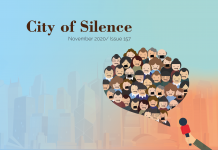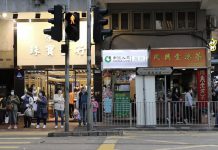Performance Artists use the body and mind to express the soul
by Benny Kung
On the last day of August this year, those who had been hoping for a more open nomination process for choosing candidates in the 2017 Chief Executive election were dealt a severe blow. The National People’s Congress Standing Committee announced a framework that would limit the number of candidates and make it almost impossible for a pan-democrat to get on the ballot paper. Two weeks later, thousands of supporters of the Occupy Central movement took to the streets on a “black cloth” march. The mood was sombre when participants joined together to carry a 500-metre long black cloth but the event did not seem to differ too much from the many protests that take place year-round in the city.
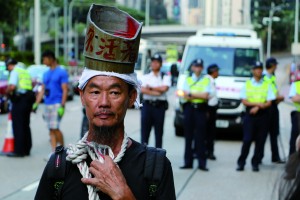
However, at the tail-end of the march, four protesters were walking backwards with Chinese characters stuck on their black clothing to suggest that democracy is regressing. An old man pulled a plastic tube attached to a piece of rope. On the tube were words attributed to Zhang Xiaoming, the head of China’s Liaison Office in Hong Kong, which suggested the central government was already very tolerant of the opposition in Hong Kong.
Other protesters and passersby took notice. “Oh, that tube is actually a used sewage pipe!” a woman yelled after staring at the tube for a while. Others, showed their appreciation more quietly.
The “happening” was actually a performance art piece.
While some may perceive performance art as a new art form, it has in fact been around since the 1950s. But it was not until the 1970s that it began to be regarded as an independent subject for study.
In 1975, renowned artist “Frog King” Kwok Mang-ho first introduced performance art to Hong Kong as an experimental art form. He splashed the contents of a big black bag of burnt ox bones next to his own award-winning sculpture at an exhibition, then sat down and discussed the ideals of art with his audience. Kwok’s work shocked local artists.
After almost four decades, Hong Kong now has 30 performance artists and the diversity of artwork has expanded accordingly.
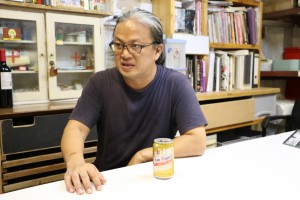
Sammu Chen, is a 51-year-old construction foreman who has been practising performance art since 1986. He was one of the five artists at the black cloth march. For him, the crucial element behind performance art is the thought behind the action, the thought which makes the artwork unique. “If someone is eating dog excrement on the street, it is not an artwork but abnormal behaviour. Actions without thoughts cannot be regarded as performance art,” Sammu explains.
He describes himself as “a supporter of humanitarianism” and his work is closely related to this theme.
Chen recalls the seemingly crazy performance art he did at the controversial Yasukuni Shrine in Japan, where the victims of war are commemorated alongside convicted war criminals.
In response to then-Japanese Prime Minister Junichiro Koizumi’s visit to the shrine on August 13 2001, Chen stood on a newspaper printed with Koizumi’s speech at the entrance of the shrine. Then he wrapped his head with newspaper, sprayed his face red, and pointed his finger at the shrine. “I made my intention clear,” Chen says. His performance took place just two days after Koizumi’s visit.
Chen was beaten up by right-wing extremists for his show, and has a scar on his forehead to show for it. But he does not regret his action.
“I don’t agree with putting victims and victimisers in the same shrine for people to worship. This is an insult to victims,” he says, “Have you ever heard of putting Jews and Nazis right next to each other?”
Chen’s performance art is not just about a purist pursuit of art. It is a way for him to express his thoughts on current issues. And he is not the only artist who feels that way about his art.
The artist Wenyau also sees performance art as a way to express her politics. She began to explore performance art when she was studying for a master’s degree in cultural and media studies in the United Kingdom and started her performance art career in 2003.
After a decade, Wenyau is now best known for her experimental performance art. She believes performance art is like “breaking the wall” – challenging the status quo.
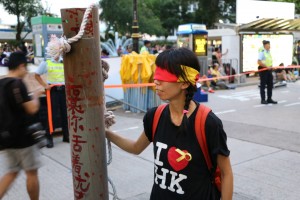
She thinks her most remarkable piece is the enactment of Homage to Seiji Shimoda: On the Table. Shimoda is a well-received performance artist in Japan who created the piece On the Table. In the piece, Shimoda moves his naked body around a wooden table without touching the ground. As Wenyau puts it, “one can see the concentrated physical energy in a breathtaking feat of stamina”.
Wenyau performed On the Table after seeking permission from Shimoda to do so at an art festival. “I just kept falling onto the ground, then trying to crawl onto the table again,” she recalls of her performance.
It moved the audience – a Japanese girl hugged her tightly after the show, and had tears coming out of her eyes when she told Wenyau how much she had enjoyed the performance.
“Seiji’s performance is about success, mine is about failure,” said Wenyau, “I put forward a question – why does a man have to master a table.”
Some critics question if performance artists, like Wenyau and Sammu Chen are too political. But for Wenyau, everything is politics. She quotes the French writer Jean Genet who said that if you do not want to be political, do not write essays or speak out.
“To me, On the Table is about gender-politics or body politics”, she adds. “Just sometimes, we perceive politics in a much narrower sense.”
Politics seems to inspire many performance artists. According to a report published by the Asian Art Archive, performance art with socio-political elements began to emerge after 1989 and has been developing ever since. It is more apparent in politically volatile years, like 1997 and 2003.
However, as an artistic way to express feelings or even political views, performance art is never easy. One thing performance artists cannot ignore is the problem of funding.
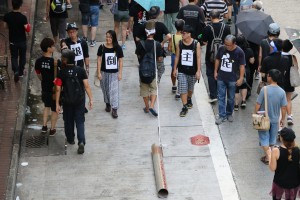
Augustine Mok Chiu-yu, the chief executive of the Centre for Community Cultural Development (CCCD), believes art is the right of everyone and continues to encourage performance art, but at the same time he also notes the difficulty in promoting it.
Last year, the CCCD held a performance and seminar session, “Inter-via Encounters between Hong Kong & Taipei’s Performance Artists”, which was aimed at enhancing the exchange of ideas for artists in the two places. It applied for funding from the Art Development Council but was rejected. Mok tried to find ways to pay for the event, including inviting the Hong Kong Society of the Deaf Youth Section to be a co-organiser. They ended up getting a 50 per cent discount for the venue booking.
While local artists struggle to cover costs and find funding, the city is often criticised for neglecting art development. Hong Kong is even frequently referred to as being something of a “cultural desert”.
But some local critics say this is unfair. Kith Tsang Tak-ping, an associate professor from the School of Design at the Hong Kong Polytechnic University, and a visual and performance artist, says it is unfair to compare the situation in Hong Kong with that of the West. “It is just because western society built up foundations hundreds of years ago. The art development there has a clear logic,” Tsang says.
Tsang thinks art development in Hong Kong has taken a different path. In the 1970s, people went to study abroad and they brought the western style of art back to the city. As time went by, inspiration from the West did give birth to the performance artists here, but it also pushed out local characteristics. Tsang says performance art in Hong Kong turns out to be very similar to the so-called “western style”.
“When the local artwork is shown overseas, the foreigners don’t even bat an eyelid at it. We found that we are the Third World in the cultural field. It is difficult to gain recognition from cultural centres such as London and Paris,” Tsang says.
To Tsang, it is time for change. He thinks performance artists should be looking for what is unique in Hong Kong’s daily life and culture, in the eastern traditions as well as within their souls.
Tsang stresses this is not in order to gain recognition, or even the understanding of their work by the public. He says artists are not overly concerned about whether the meanings behind their performances are discerned. “Real artists do not need to consider these things. It is all about pursuing the ideals deep in their hearts,” he says.
Edited by Elaine Tsang




